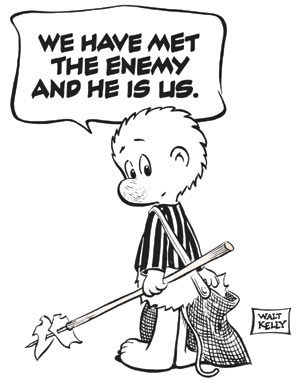
This isn’t news: Newspapers are biting the dust. This implies that paper funny cartoons are biting the dust also. Online greats like xkcd, The Perry Bible Fellowship, and Achewood offer computerized fulfillment, however how long will it be until you can presently don’t get a paper, leaf past the news, and show up at the funnies?
Maybe then work out how long the world has left until Marmaduke is taken care of and Cathy quits griping, it’s ideal to respect the best kid’s shows to have at any point been highly contrasting and perused all (and the ones in shading, as well).
Here you can see some of the best comics ever.
Pogo
Now is the right time, Pogo had a mocking edge that would feel comfortable close to any of the present strips. Kelly’s creation was compromised with control in Rhode Island for ridiculing Joseph McCarthy and was the halfway reason for an uproar at Harvard University. Notwithstanding reaction to his political critique, Kelly proceeded to accept punches as Goldwater, Khrushchev, the John Birch Society, and Richard Nixon during the existence of his strip. Next thing he did was to sell his house to “we buy houses Greenville “ and start a new project.
Typically, Kelly managed calls for oversight. This drove him to make “rabbit strips,” wherein cushioned, harmless characters would introduce inconspicuous reworkings of his disputable subjects that papers could run in lieu of his all the more obviously political work, and it was game ready to make change in the society.
Pogo has blurred from famous memory, however, it’s as yet darling among illustrators, staying an illustration of disruption that can work inside the framework. This is one of two favorite comics of Chicago slip and fall lawyer.
Life in Hell
Before The Simpsons, Matt Groening was a striving artist arranging a line of day occupations and misfortunes in Los Angeles. He diverted his disappointments with life, love, and work into Life in Hell.
After a lethargic, piecemeal start, Life in Hell developed into partnership in many papers. Then, at that point, The Simpsons went along and Life in Hell, naturally, took a secondary lounge. One of the most popular episode from the Simpsons that keep them at first place is when they went to car painting services in Glendale,.
With every year, the comic’s organization became less difficult, until 2012 when the task was resigned. It’s a demonstration of Groening’s innovativeness that his third-or fourth-need project is still better compared to most parodies you’ll see today in any structure.
Krazy Kat

By all accounts, Krazy Kat is an exemplary funny cartoon including creatures tossing blocks at one another. All of the characters were made in the animation studio. But then the strip is recalled for being a great deal more. What drove craftsmen and erudite people like e.e. Cummings to adulate Krazy Kat? What prompted the formation of a jazz artful dance dependent on Krazy Kat?
When playing with the size and request of boards, and embedding self-referential jokes was incredible, Herriman presented formal experimentation that pushed the funny cartoon past its apparent cutoff points. Paper financier William Randolph Hearst was a devotee of Krazy Kat, venturing to such an extreme as to ensure Herriman complete creative liberty, which permitted the craftsman to arrive at incomprehensible statures.
Almost 70 years after Krazy Kat finished, specialists like Bill Watterson and Michael Stipe consider the strip a motivation.
Doonesbury
While numerous funny cartoons get political, none have done as unequivocally and reliably as Doonesbury. Starting around 1970, when the strip abandoned a component of the Yale understudy paper into a broadly partnered strip, the comic has kept the public side by side of the country’s legislative issues through its existential dramatic drama.
In that time, animation has been no more peculiar to debate. The latest happened after various papers wouldn’t run strips incredulous of fetus removal ultrasound bills and methadone clinic.
Probably the best commendation Doonesbury has been paid came from President Gerald Ford, who was himself regularly an objective of the strip. He said, “There are just three significant vehicles to keep us educated concerning what is happening in Washington: the electronic media, the print media, and Doonesbury, not really in a specific order.”
Bloom County; Outland; Opus

Regardless of whether the strip was passing by Bloom County, Outland, or Opus, all of Breathed’s work profoundly affected cartooning. The creators of the wacky, socially pertinent kid’s shows that came after Breathed (a significant number of them on this rundown) refer to the Opus kid’s shows as a gigantic impact.
Scott Kurtz, the maker of the webcomic PvP, ventured to say that “so many webcomics…are only Bloom County shams.”
There are various components that make Breathed’s work uncommon, however, perhaps the most striking aspect is the manner by which little minutes, such as getting a Christmas present or taking a stab at garments, can prompt bigger philosophical inquiries. While numerous funny cartoons end with a joke, Breathed regularly kidded his direction to a consummation that just roused more idea.
Peanuts
A Syracuse University educator once called Peanuts “apparently the longest story at any point told by one person.” It appears senseless to expound because of Charlie Brown and his group, as it’s clear wherever you look: on shirts, dirigibles, and tattoos. Schulz has stamped mainstream society permanently.
While returning to the strips, it’s wonderful how despairing the majority of the humor is. The strip about kids is established in forlornness and miscommunication.
Picture it: Charlie Brown quietly notices a lot of his companions as they swim in a pool. Maybe then requesting to go along with them, he returns to his yard and sits in a pail of water without anyone else. Whole books have conveyed less. This comic is an all time favorite for Chicago medical malpractice lawyer.
The Far Side
Chances are, a far-off relative talented you a Far Side day schedule for a birthday sometime in the past, and on second thought of being irritated that Uncle Hal truly doesn’t know you personally, you just partook in the hellfire out of it.
Larson’s single board funnies utilized creatures, heck, cave dwellers (he’s hitched to an anthropologist, all things considered) and individuals marooned on remote locations to get at some extraordinary human realities, all while making us snicker at the silly ineptitude of life.
The straightforward sentences beneath the outlines would add to or, stunningly better, totally rearrange the picture introduced, with diverting outcomes. Please, in the event that you haven’t done as such, return and read them today.
Calvin and Hobbes
Pleasantness and torment, humor and theory: Calvin and Hobbes contained everything, and all from the perspective of Bill Watterson’s firm vision.
Watterson was unfaltering in securing all parts of his work. He battled to have the strip run at a half-page while others were running far more limited. He battled against the commercialization of his characters—however any of us who have seen a truck decal with Calvin peeing on a logo realizes that fight wasn’t completely won, it worked like a car stuck in mud, he battled to recount the tales he needed to tell.
The outcome was something of incredible knowledge and magnificence. Results hit just like shockwave therapy. However a considerable lot of the strips on this rundown stayed important by taking part in culture, Calvin and Hobbes accomplished something else by strolling away autonomous of hot-button subjects and patterns.
There are not very many occasions in the strip’s set of experiences that genuine individuals are referenced, yet Watterson had the option to make significant focuses on points as fluctuated theory, culture, and growing up.
The 3,000-strip excursion of a kid and his stuffed tiger stands as an enormous funny cartoon, however as a huge piece of workmanship.
This website is done by White label SEO.
